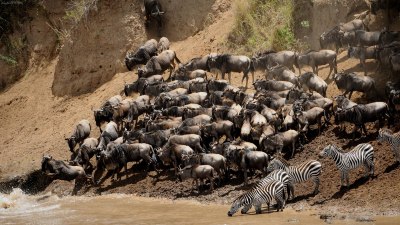How Weather Shapes Animal Migration in Surprising Ways
Discover the fascinating relationship between weather patterns and animal migration behaviors in this comprehensive analysis.

Weather is an essential factor influencing animal behavior, and one of the most significant aspects of this is migration. Each year, millions of animals embark on long journeys, navigating vast distances to find food, reproduction grounds, or favorable climates. Understanding how weather impacts these migrations reveals the intricate connections between animals and their environments. Weather patterns, including temperature changes, precipitation levels, and seasonal shifts, play a pivotal role in determining not just when and where animals migrate, but also how successfully they adapt to the challenges they encounter along the way.
Temperature Influence on Migration Timing
One of the most direct relationships between weather and migration is seen in the timing of these journeys, particularly concerning temperature. Many species of birds, such as geese and swans, migrate based on temperature shifts. As winter arrives and temperatures drop, these birds instinctively move south to more temperate climates where food sources remain available. Conversely, the arrival of spring allows them to return north to their breeding grounds, where warmer temperatures signal the onset of a new breeding season. Intriguingly, shifts in the average temperatures can cause these birds to migrate earlier or later than in previous years. Climate change has begun to affect the migratory cycles of various species, resulting in mismatches between the arrival of migratory birds and the availability of resources, such as insects and plants.
Impact of Precipitation Patterns
Weather is not solely about temperature; precipitation patterns also have a significant impact on migration. For many animals, particularly those living in arid regions, the timing of rains can dictate their movement. Species such as wildebeests in the Serengeti migrate in response to the rains, moving towards areas where grass is plentiful after the rains replenish the landscape. This ensures they have access to food sources, maintaining their energy levels throughout their journey. Conversely, drought conditions can lead to reduced vegetation, prompting these animals to change their migration paths or delay their movements altogether. Tracking these changes poses challenges for conservation efforts, as their behaviors may become less predictable in response to fluctuating weather conditions.
Wind Patterns and Migration Routes
Wind patterns are another critical factor influencing animal migration. Many bird species rely on favorable wind conditions to assist their long-distance flights. For instance, migratory birds such as the Swallow and the Arctic Tern utilize tailwinds to conserve energy during their arduous journeys. Unpredictable weather systems can dramatically alter these wind patterns, either benefiting or hindering migratory birds. A sudden storm can create headwinds that force birds to expend more energy or even get blown off course, complicating their routes and increasing travel times. Thus, understanding seasonal wind patterns helps ornithologists develop more accurate models of migratory behaviors.
Effects of Climate Change on Migration Patterns
As climate change continues to reshape global weather patterns, the effects on animal migration are becoming increasingly evident. For many species, the historic cues for migration timing are becoming less reliable. For example, some birds are migrating earlier in the spring as temperatures warm sooner, creating potential mismatches between when they arrive at their breeding sites and when food sources are available. Studies have shown that many migratory species are shifting their ranges northward, seeking cooler habitats due to the warming climate. These shifts not only complicate traditional migration routes but can lead to increased competition and predation as animals encounter new species in their altered habitats. Conservationists are now facing the challenge of predicting and managing these changes to help protect vulnerable species.
Migratory Pathways and Obstacle Navigation
Migrating animals must navigate a myriad of obstacles during their journeys, many of which are weather-related. For example, storms can present dangerous conditions for birds attempting to cross oceans. Some species exhibit strategic behaviors to mitigate the risks of storms, such as waiting for favorable weather before embarking on their flights. Others, like the Monarch butterfly, utilize weather patterns for their migration. These butterflies rely on thermals—updrafts of warm air—to glide efficiently from one breeding ground to another. Understanding these navigational skills is essential for conservationists looking to protect migratory routes and the habitats that support them.
Case Studies: Observing Migration in Action
Several case studies exemplify how weather influences animal migration. In North America, the migration of the American Robin is closely tied to temperature changes. A milder winter typically results in an earlier migration, allowing these birds access to food sources that would otherwise be buried under snow. In Africa, the migration of the Serengeti wildebeests is contingent on the seasonal rains that stimulate grass growth, exemplifying how precipitation patterns drive their movement. Furthermore, Monarch butterflies serve as a poignant case study showcasing the delicate balance between atmospheric conditions and migration. Their reliance on specific temperature and weather patterns for successful travel underscores the challenges migrating species face in a changing climate.
Human Impact on Migration Patterns
The impact of human activity on migration patterns cannot be ignored. Increased urbanization, deforestation, and climate change have all played substantial roles in altering migratory pathways. Urban development often fragments habitats and disrupts migration routes, making it difficult for animals to find suitable environments along their journeys. Conservation efforts are urgently needed to create safe corridors that allow animals to move freely between habitats. Additionally, regions susceptible to climate change-related natural disasters, such as flooding or wildfires, can further complicate established migratory routes. Understanding and mitigating these human-induced changes is crucial for maintaining healthy migratory populations.
The Future of Animal Migration
The ongoing changes in weather patterns due to climate change raise critical questions about the future of animal migration. Adaptation will be key for many species as they attempt to cope with shifting conditions. Some animals may successfully adapt, altering their migration timing, routes, or even destination locations. However, others—especially those with limited mobility or specialized habitats—may face significant challenges, leading to population declines or extinctions. Monitoring these changes through innovative techniques such as GPS tracking and remote sensing will provide essential data to understand how species are responding to their new environmental realities.
In conclusion, weather has a profound impact on animal migration, shaping behaviors, routes, and timings. Understanding these relationships helps us appreciate the delicate interplay between weather and wildlife, highlighting the need for conservation efforts that consider these factors. As temperatures rise, rainfall patterns shift, and weather becomes increasingly unpredictable, the future of many migratory species hangs in the balance. By advocating for sustainable practices and protecting natural habitats, we can help ensure that the wonders of animal migration continue for generations to come.











